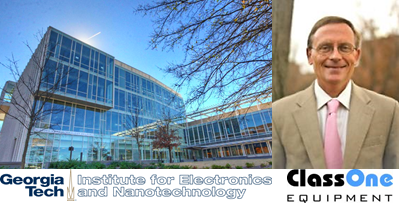event
IEN Technical Seminar Series on Advanced Fabrication: Thermal Considerations in Metal Deposition by Evaporation Professor Peter J. Hesketh — School of Mechanical Engineering
Primary tabs
Abstract: Evaporation is one of the most widely used methods for thin film deposition in integrated circuit fabrication and MEMS, particularly for metals. The evaporation rate depends upon the vapor pressure of the source, which is a function of the temperature of the crucible.Impurities can also be incorporated into the deposited film due to the presence of residual gases and the heating that takes place in the chamber. The thickness of the deposited film is a function of the arrival flux of vapor and geometry of substrate fixture in the chamber. The use of solid-angle and view factor will be discussed. At the same time as film growth there is also an incident radiant heat flux which heats up the substrate and film, resulting in thermal stresses due to the difference in temperature coefficient of expansion. Using a diffuse gray model for surface properties, the steady-state temperature of the wafer/substrate can be estimated using an equivalent circuit model. The wafer temperature is a strong function of the source temperature, solid angle, and depends on the presence or absence of a shield in the vacuum chamber.
Biography: Peter Hesketh received a B.Sc. in Electrical and Electronic Engineering from the University of Leeds (1979) and was a Thouron Fellow at the University of Pennsylvania, obtaining an M.S. (1983) Ph.D. (1987) in Electrical Engineering. He worked in the Microsensor Group at the Physical Electronics Laboratory of Stanford Research Institute and then Teknekron Sensor Development Corporation before joining the faculty at the University of Illinois in 1990 in the Department of Electrical Engineering and Computer Science. He is currently a Professor of Mechanical Engineering at Georgia Institute of Technology, Member of the Parker H. Petit Institute for Bioengineering and Biosciences, and Director of the Micro and Nano Engineering Group in the School of Mechanical Engineering. His research interests include micro/nanofabrication techniques, microcantilever chemical sensors, miniature gas chromatography systems, and sensors for the detection of microbial contamination of foods. He has published over seventy journal papers and edited fifteen books on microsystems. He is a Fellow of the AAAS, ASME, ECS, a member of ASEE, Sigma Xi, and IEEE.
Groups
Status
- Workflow Status:Published
- Created By:Christa Ernst
- Created:02/27/2014
- Modified By:Fletcher Moore
- Modified:04/13/2017
Categories
Keywords
Target Audience

